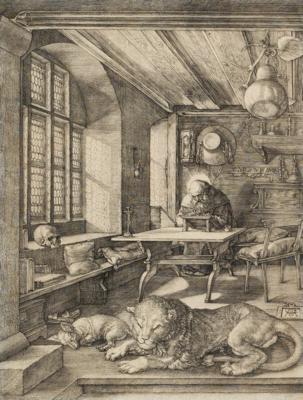Albrecht Dürer

(Nuremberg 1471-1528)
Saint Jerome in his Study, 1514, engraving on laid paper, monogrammed and dated AD 1514 in the plate, 24,5 x 18,6 cm, trimmed within platemarks, Bartsch 60, Meder 59 b-c (of f), mounted, gerahmt, (Sch)
Provenance:
Private collection, Italien.
Very excellent, clear and even impression. Meder 59 b-c, prior to the curved scratch and the vertical line on the door of the box, on laid paper without watermark. In an excellent condition.
The present engraving depicting „Saint Jerome“, belongs to the so-called master prints in Dürer’s oeuvre together with the engravings “Knight, Death, and Devil” (1513 and “Melencolia I” (1514). They are the best known works of the artist, due to their tactile quality, their materiality and the richness of their tonal values. Although Albrecht Dürer never mentioned the three prints together in his diary entries and although there is no evidence that he conceived them as a tryptich or a series the three prints are related with each other in a spiritual sense, due to the same format, their technical virtuosity and the focus on a single figure in a setting that is loaded with symbolic contents. Various theories exist about the symbolic relationship among the three sheets, such as that they may represent an incomplete series of the “Four Temperaments” or a depiction of “The Three Virtues” (intellectuales, morales, et theologicales). Accordingly, Saint Jerome would represent contemplative life, and “Knight, Death, and Devil” and “Melencolia I” would stand in turn for the opposite of Saint Jerome and represent active life. The significance of the perspective construction of the scholar’s study and the optical distortion of the picture’s space has been widely interpreted. The crucifix on the table is in a line with the saint and the skull, which stand for vanity and are therefore related to death and resurrection. The candle on the shelf, which is burnt down points to the end of life, as does the hour glass, which reminds one of the passing of time. The lion in the foreground is part of the traditional iconography of the saint such as the sleeping dog which is also mentioned in the stories about Saint Jerome passed on in the “Legenda Aurea”. The dry gourd hanging from the ceiling refers to the theological dispute with Saint Augustine and to the question which plant is meant, whether gourd vine or ivy concerning the correct interpretation of the Hebrew word „kikayon“ (Jona 4:6).
Esperta: Mag. Astrid-Christina Schierz
 Mag. Astrid-Christina Schierz
Mag. Astrid-Christina Schierz
+43-1-515 60-546
astrid.schierz@dorotheum.at
04.04.2023 - 13:05
- Prezzo realizzato: **
-
EUR 65.000,-
- Stima:
-
EUR 25.000,- a EUR 30.000,-
- Prezzo di partenza:
-
EUR 23.000,-
Albrecht Dürer
(Nuremberg 1471-1528)
Saint Jerome in his Study, 1514, engraving on laid paper, monogrammed and dated AD 1514 in the plate, 24,5 x 18,6 cm, trimmed within platemarks, Bartsch 60, Meder 59 b-c (of f), mounted, gerahmt, (Sch)
Provenance:
Private collection, Italien.
Very excellent, clear and even impression. Meder 59 b-c, prior to the curved scratch and the vertical line on the door of the box, on laid paper without watermark. In an excellent condition.
The present engraving depicting „Saint Jerome“, belongs to the so-called master prints in Dürer’s oeuvre together with the engravings “Knight, Death, and Devil” (1513 and “Melencolia I” (1514). They are the best known works of the artist, due to their tactile quality, their materiality and the richness of their tonal values. Although Albrecht Dürer never mentioned the three prints together in his diary entries and although there is no evidence that he conceived them as a tryptich or a series the three prints are related with each other in a spiritual sense, due to the same format, their technical virtuosity and the focus on a single figure in a setting that is loaded with symbolic contents. Various theories exist about the symbolic relationship among the three sheets, such as that they may represent an incomplete series of the “Four Temperaments” or a depiction of “The Three Virtues” (intellectuales, morales, et theologicales). Accordingly, Saint Jerome would represent contemplative life, and “Knight, Death, and Devil” and “Melencolia I” would stand in turn for the opposite of Saint Jerome and represent active life. The significance of the perspective construction of the scholar’s study and the optical distortion of the picture’s space has been widely interpreted. The crucifix on the table is in a line with the saint and the skull, which stand for vanity and are therefore related to death and resurrection. The candle on the shelf, which is burnt down points to the end of life, as does the hour glass, which reminds one of the passing of time. The lion in the foreground is part of the traditional iconography of the saint such as the sleeping dog which is also mentioned in the stories about Saint Jerome passed on in the “Legenda Aurea”. The dry gourd hanging from the ceiling refers to the theological dispute with Saint Augustine and to the question which plant is meant, whether gourd vine or ivy concerning the correct interpretation of the Hebrew word „kikayon“ (Jona 4:6).
Esperta: Mag. Astrid-Christina Schierz
 Mag. Astrid-Christina Schierz
Mag. Astrid-Christina Schierz
+43-1-515 60-546
astrid.schierz@dorotheum.at
|
Hotline dell'acquirente
lun-ven: 10.00 - 17.00
kundendienst@dorotheum.at +43 1 515 60 200 |
| Asta: | Disegni e stampe d'autore fino al 1900 |
| Tipo d'asta: | Asta online |
| Data: | 04.04.2023 - 13:05 |
| Luogo dell'asta: | Wien | Palais Dorotheum |
| Esposizione: | 29.03. - 04.04.2023 |
** Prezzo d'acquisto comprensivo di tassa di vendita e IVA
Non è più possibile effettuare un ordine di acquisto su Internet. L'asta è in preparazione o è già stata eseguita.
